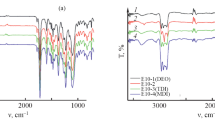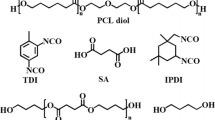Abstract
A series of block poly(ester-ether urethane)s, poly(PHB/PCL-PEG-PCL), based on poly(3-hydroxybutyrate) (PHB-diol), as hard segments, and poly(ε-caprolactone)-b-poly(ethylene glycol)-b-poly(ε-caprolactone), (PCL-PEG-PCL) triblock copolydiol, as soft segments, were prepared using 1,6-hexamethylene diisocyanate (HDI), as non-toxic connecting agent. Polyurethanes block copolymer was synthesized from bacterial PHB and PCL-PEG-PCL blocks. The chemical structure and molecular weights of polymers prepared were characterized by FTIR, 1H NMR and GPC. The effect of chemical structure on the thermal and mechanical properties was studied by differential scanning calorimetry (DSC), thermogravimetric analysis (TGA), and tensile testing. The DSC results revealed that poly(PHB/PCL-PEG-PCL) urethanes are semi-crystalline with two crystallizable PHB and PCL-PEG-PCL blocks. The thermal stability of the urethanes is less than neat PHB. The results of tensile testing showed that the extensibility of PHB is largely enhanced by the incorporation of PCL-PEG-PCL soft segments. Activation energy E a , as a kinetic parameter of thermal decomposition, was estimated by each of the Ozawa and Kissinger methods. Close values of activation energy were obtained by both methods. The swelling behaviour of the copolymers was also investigated.










Similar content being viewed by others
References
Doi Y (1990) Microbial polyester. VCH, New York
Steinbüchel A (1996) PHB and other polyhydroxyalkanoic acids. In: Rehm H-J, Reed G, Pühler A, Stadler P (eds) Biotechnology, vol. 6. Wiley, Weinheim, pp 403–464
Lenz RW, Marchessault RH (2005) Bacterial polyesters: biosynthesis, biodegradable plastics and biotechnology. Biomacromolecules 6:1–8
Nonato RV, Mantelatto PE, Rossell CEV (2001) Integrated production of biodegradable plastic, sugar and ethanol. Appl Microbiol Biotechnol 57:1–5
Grassie N, Murray EJ, Holmes PA (1984) Thermal degradation of poly(-(D)-β-hydroxybutyric acid): part 3—The reaction mechanism. Polym Degrad Stab 6:127–134
Grassie N, Murray EJ, Holmes PA (1984) Thermal degradation of poly(-(D)-β-hydroxybutyric acid): part 1—Identification and quantitative analysis of products. Polym Degrad Stab 6:47–61
Grassie N, Murray EJ, Holmes PA (1984) Thermal degradation of poly(-(D)-β-hydroxybutyric acid): part 2—Changes in molecular weight. Polym Degrad Stab 6:95–103
Hirt TD, Neuenschwander P, Suter UW (1996) Synthesis of degradable, biocompatible, and tough block-copolyesterurethanes. Macromol Chem Phys 197:4253–4268
Lendlein A, Neuenschwander P, Suter UW (1998) Tissue-compatible multiblock copolymers for medical applications, controllable in degradation rate and mechanical properties. Macromol Chem Phys 199:2785–2796
Saad GR, Lee YJ, Seliger H (2002) Synthesis and characterization of biodegradable poly(ester-urethanes) based on bacterial poly(R-3-hydroxybutyrate). J Appl Poly Sci 83:703–718
Saad GR (2001) Calorimetric and dielectric study of the segmented biodegradable poly(ester-urethane)s based on bacterial poly(R-3-hydroxybutyrate). Macromol Biosci 1:387–396
Saad GR, Seliger H (2004) Biodegradable copolymers based on bacterial poly(R-3-hydroxybutyrate): thermal and mechanical properties and biodegradation behaviour. Polym Degrad Stab 83:101–110
Zhao Q, Cheng G, Li H, Ma X, Zhang L (2005) Synthesis and characterization of biodegradable poly(3-hydroxybutyrate) and poly(ethylene glycol) multiblock copolymers. Polymer 46:10561–10567
Zhao Q, Cheng G (2004) Preparation of biodegradable poly(3-hydroxybutyrate) and poly(ethylene glycol) multiblock copolymers. J Mater Sci 39:3829–3831
Zhao Q, Cheng G, Song C, Zeng Y, Tao J, Zhang L (2006) Crystallization behavior and biodegradation of poly(3-hydroxybutyrate) and poly(ethylene glycol) multiblock copolymers. Polym Degrad Stab 91:1240–1246
Li X, Loh XJ, Wang K, He C, Li J (2005) Poly(ester urethane)s consisting of poly[(R)-3-hydroxybutyrate] and poly(ethylene glycol) as candidate biomaterials: characterization and mechanical property study. Biomacromolecules 6:2740–2747
Loh XJ, Tan KK, Li X, Li J (2006) The in vitro hydrolysis of poly(ester urethane)s consisting of poly[(R)-3-hydroxybutyrate] and poly(ethylene glycol). Biomaterials 27:1841–1850
Loh XJ, Goh SH, Li J (2007) Hydrolytic degradation and protein release studies of thermogelling polyurethane copolymers consisting of poly[(R)-3-hydroxybutyrate], poly(ethylene glycol), and poly(propylene glycol). Biomaterials 28:4113–4123
Zhang C, Zhang N, Wen X (2007) Synthesis and characterization of biocompatible, degradable, light curable, polyurethane-based elastic hydrogels. J Biomed Mater Res 82:637–650
Gorna K, Polowinski S, Gogolewski S (2002) Synthesis and characterization of biodegradable poly(ε-caprolactone urethane)s. I. Effect of the polyol molecular weight, catalyst and chain extender on the molecular and physical characteristics. J Polym Sci Polym Chem 40:156–170
Férnandez AM, Abraham GA, Valentin JL, Róman JS (2006) Synthesis and characterization of biodegradable non-toxic poly(ester-urethane-urea)s based on poly(ε-caprolactone) and amino acid derivatives. Polymer 47:785–798
Quintana P, Bartolo-Pérez P (2010) Degradation studies on segmented polyurethanes prepared with HMDI, PCL and different chain extenders. Acta Biomater 6:2035–2044
Rueda-Larraz L, Fernandez d’Arlas B, Tercjak A, Ribes A, Mondragon I, Eceiza A (2009) Synthesis and microstructure–mechanical property relationships of segmented polyurethanes based on a PCL–PTHF–PCL block copolymer as soft segment. Eur Polym J 45:2096–2109
Saad GR, Lee YJ, Seliger H (2001) Synthesis and thermal properties of biodegradable poly(ester-urethane)s based on chemo-synthetic poly[(R, S)-3-hydroxybutyrate]. Macromol Biosci 1:91–99
Guan J, Fujimoto KL, Sacks MS, Wagner WR (2005) Preparation and characterization of highly porous, biodegradable scaffolds for soft tissue applications. Biomaterials 26:3961–3971
Rodrigues da Silva G, Junior A, Behar-Cohen F, Ayres E, Oréfice RL (2010) Biodegradation of polyurethanes and nanocomposites to non-cytotoxic degradation products. Polym Degrad Stab 95:491–499
Piao L, Dai Z, Deng M, Chen X, Jing X (2003) Synthesis and characterization of PCL/PEG/PCL triblock copolymers by using calcium catalyst. Polymer 44:2025–2031
Yen M, Kuo S (1997) PCL-PEG-PCL triblock copolydiol-based waterborne polyurethane. I. Effects of the soft-segment composition on the structure and physical properties. J Appl Polym Sci 65:883–392
Mahkam M, Sanjani MS (2003) Preparation of new biodegradable polyurethanes as a therapeutic agent. Polym Degrad Stab 80:199–202
Jiang X, Li J, Ding M, Tan H, Ling Q, Zhong Y, Fu Q (2007) Synthesis and degradation of nontoxic biodegradable waterborne polyurethanes elastomer with poly(ε-caprolactone) and poly(ethylene glycol) as soft segment. Eur Polym J 43:1838–1846
Srichatrapiuumuk VW, Cooper SL (1978) Infrared thermal analysis of polyurethane block polymers. J Macromol Sci Phys B15(2):267–311
Coleman MM, Skrovanek DJ, Hu J, Painter PC (1988) Hydrogen bonding in polymer blends. 1. FTIR studies of urethane-ether blends. Macromolecules 21(1):59–65
Barham PJ, Keller A, Otun EL, Holmes PA (1984) Crystallization and morphology of a bacterial thermoplastic: poly-3-hydroxybutyrate. J Mater Sci 19:2781–2794
Pan J, Li G, Chen Z, Chen X, Zhu W, XU K (2009) Alternative block polyurethanes based on poly(3-hydroxybutyrate-co-4-hydroxybutyrate) and poly(ethylene glycol). Biomaterials 30:2975–2984
Kissinger HE (1957) Reaction kinetics in differential thermal analysis. Anal Chem 29:1702–1706
Ozawa T (1965) A new method of analyzing thermogravimetric data. Bull Chem Soc Jpn 38:1881–1886
Flynn JH, Wall LA (1966) A quick direct method for the determination of activation energy from thermogravimetric data. J Polym Sci Polym Lett Ed 4:323–328
Chen C, Fei B, Peng S, Zhuang Y, Dong L, Feng ZJ (2002) The kinetics of the thermal decomposition of poly(3-hydroxybutyrate) and maleated poly(3-hydroxybutyrate). Appl Polym Sci 84:1789–1796
Erceg M, Kovačić T, Perinović S (2008) Kinetic analysis of the non-isothermal degradation of poly(3-hydroxybutyrate) nanocomposites. Thermochim Acta 476:44–50
Yeo SY, Tan WL, Abu Bakar M, Ismail J (2010) Silver sulfide/poly(3-hydroxybutyrate) nanocomposites: thermal stability and kinetic analysis of thermal degradation. Polym Degrad Stab xxx:1–6, article under press
Lee MY, Lee TS, Park WH (2001) Effect of side chains on the thermal degradation of poly(3-hydroxyalkanoates). Macromol Chem Phys 202:1257–1261
Li S-D, He J-D, Yu PH, Cheung MK (2003) Thermal degradation of poly(3-hydroxybutyrate) and poly(3-hydroxybutyrate-co-3-hydroxyvalerate) as studied by TG, TG-FTIR, and Py-GC/MS. J Appl Polym Sci 89:1530–1536
Acknowledgment
Special thanks to Cairo University for supporting this research through Graduate Research Challenge Fund (GRCF) for distinguished young researchers.
Author information
Authors and Affiliations
Corresponding author
Rights and permissions
About this article
Cite this article
Naguib, H.F., Abdel Aziz, M.S., Sherif, S.M. et al. Synthesis and thermal characterization of poly(ester-ether urethane)s based on PHB and PCL-PEG-PCL blocks. J Polym Res 18, 1217–1227 (2011). https://doi.org/10.1007/s10965-010-9525-y
Received:
Accepted:
Published:
Issue Date:
DOI: https://doi.org/10.1007/s10965-010-9525-y




